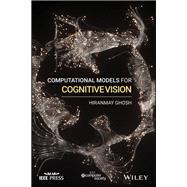Learn how to apply cognitive principles to the problems of computer vision
Computational Models for Cognitive Vision formulates the computational models for the cognitive principles found in biological vision, and applies those models to computer vision tasks. Such principles include perceptual grouping, attention, visual quality and aesthetics, knowledge-based interpretation and learning, to name a few. The author’s ultimate goal is to provide a framework for creation of a machine vision system with the capability and versatility of the human vision.
Written by Dr. Hiranmay Ghosh, the book takes readers through the basic principles and the computational models for cognitive vision, Bayesian reasoning for perception and cognition, and other related topics, before establishing the relationship of cognitive vision with the multi-disciplinary field broadly referred to as “artificial intelligence”. The principles are illustrated with diverse application examples in computer vision, such as computational photography, digital heritage and social robots. The author concludes with suggestions for future research and salient observations about the state of the field of cognitive vision.
Other topics covered in the book include:
· knowledge representation techniques
· evolution of cognitive architectures
· deep learning approaches for visual cognition
Undergraduate students, graduate students, engineers, and researchers interested in cognitive vision will consider this an indispensable and practical resource in the development and study of computer vision.









